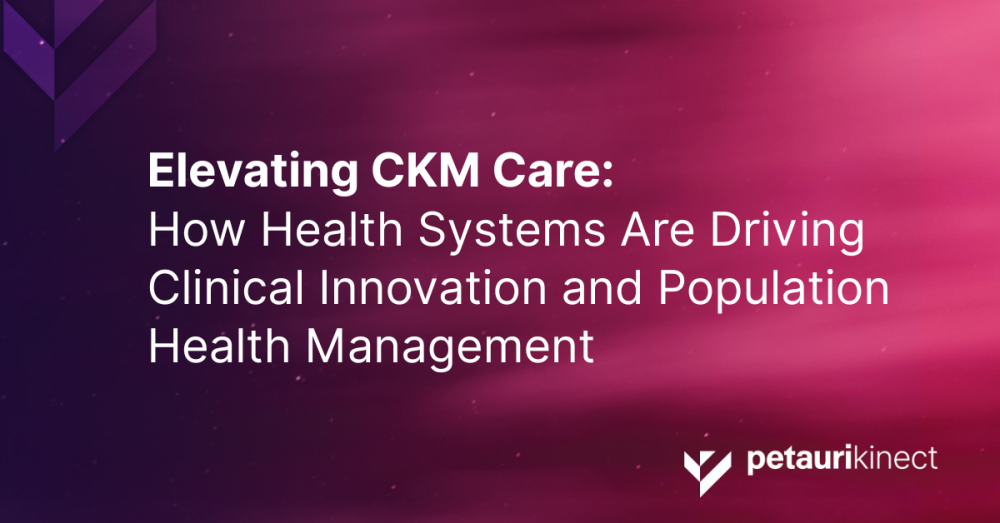Elevating CKM Care: How Health Systems Are Driving Clinical Innovation and Population Health Management

The Problem
The proportion of adults with cardiovascular-kidney-metabolic (CKM) syndrome increased by 7% from 2017-2019 to 2020-2022.1 As the prevalence of CKM syndrome continues to rise, health systems are proactively defining approaches in care management. With a commitment to multidisciplinary care, clinical excellence and system-wide integration, hospitals and health systems are aligning strategies to better serve CKM populations. Thus, it is imperative that health systems not only address individual conditions but also recognize the interconnected nature of CKM syndrome.
The Role of Health Systems in Enhancing Integrated and Standardized CKM Care
Health systems are implementing diverse strategies to improve CKM patient care delivery.
Establishing Centers of Excellence for CKM Care
The complexity of diagnosing, monitoring and treating CKM syndrome lies in its interconnected nature, with each component often coexisting and exacerbating the others. This challenge is usually compounded by the fragmented nature of healthcare at the patient, clinical, system and policy levels.
Recognizing the need for an integrated approach, health systems are laying a strong foundation by creating CKM clinics and centers of excellence. These facilities are designed to provide comprehensive, patient-centered care, bringing together a range of specialists, including cardiologists, nephrologists, endocrinologists, hepatologists and other relevant specialists. By addressing all aspects of care in a coordinated manner, multidisciplinary teams can more effectively treat CKM syndrome and enhance patient care.
For example, Cleveland Clinic, a leading health system renowned for its expertise and innovation, has recognized the increasing incidence of CKM syndrome. Their cardiology department is gaining expertise in diagnosing and treating the full spectrum of cardiovascular diseases. Additionally, at the Cleveland Clinic Center for Chronic Kidney Disease, experts in kidney medicine collaborate with multidisciplinary physicians to treat patients, enabling providers to connect treatment pathways across heart, kidney and metabolic health for optimal patient outcomes.2
Streamlining Care Through Consolidation
The consolidation of physician practices under health systems is another critical trend reshaping CKM care. Integrating independent providers into larger networks allows health systems to better coordinate care delivery, reduce inefficiencies and ensure consistency in clinical protocols.
Kaiser Permanente is a prime example of effective consolidation in action. With its vertically integrated model, Kaiser Permanente ensures that CKM patients have access to a unified network of specialists and services. Their approach leverages shared electronic health records (EHRs) to enhance communication and decision-making, allowing for more precise population health management.3
Improving Population Health Management
Health systems are evolving their population health strategies to prioritize early detection, prevention and management of CKM syndrome. Disease registries, risk stratification tools and community outreach programs enable providers to proactively identify and support populations at risk.
For instance, Geisinger has implemented a data-driven approach to CKM care, utilizing predictive analytics to identify patients at high risk for CKM complications. Their innovative care model includes preventive screenings, lifestyle modification programs and access to cutting-edge therapies.4
In parallel, Ascension is focusing on community health initiatives that address the social determinants of health (SDOH) impacting CKM patients. By collaborating with local organizations, Ascension is working to bridge gaps in care access and promote healthier lifestyles within underserved communities.5
The Road Ahead for CKM Care
As health systems adopt new treatments and technologies to manage CKM syndrome, they are faced with clinical inertia, which refers to the failure to initiate or intensify therapy when needed. This inertia can significantly impact the management of CKM syndrome. To overcome clinical inertia, they must establish a new paradigm of care. In doing so, they are seeking collaboration opportunities that can help provide scalable solutions to address their clinical and operational needs.
The establishment of CKM clinics, the rise of physician practice consolidation and the integration of multidisciplinary care models signal a transformative shift in how health systems manage CKM syndrome. By prioritizing clinical excellence, early detection, and comprehensive care, health systems are setting a new standard for population health management.
The Solution
The path forward is clear: through collaboration, innovation and focus on patient-centered care, healthcare leaders can collectively transform the management of CKM syndrome and redefine what is possible in healthcare.
Petauri Kinect Can Help Drive Clinical Innovation in CKM Care
Petauri Kinect’s team of health systems experts can offer insights into the evolving CKM market through our Networks of Excellence, which focus on therapeutic areas such as heart health, metabolic dysfunction–associated steatohepatitis (MASH) and chronic kidney disease (CKD). Petauri Kinect can empower our life science partners with innovative solutions and engagement strategies that align with health system goals related to enhancing integrated CKM care.
We encourage you to stay tuned for future posts in this series, which will describe our expertise in the CKM market and delve further into the economic factors that health systems focus on to improve the management of this condition.
Petauri Kinect Can Be Your Trusted Partner
Petauri Kinect is the only strategic advisory and marketing agency dedicated to health system and therapeutic area dynamics. With our proven process for uncovering opportunities, we act as an extension of your team to build markets and optimize adoption.
Reach out to our therapeutic teams here to schedule a capabilities meeting and take the next step with us!
References
1. Trimarco V, Izzo R, Pacella D, et al. Increased prevalence of cardiovascular-kidney-metabolic syndrome during COVID-19: a propensity score-matched study. Diabetes Res Clin Pract. 2024;218:111926. doi: 10.1016/j.diabres.2024.111926
2. Chronic kidney disease. Cleveland Clinic. Accessed April 24, 2025. https://my.clevelandclinic.org/departments/urology-kidney/depts/chronic-kidney-disease#overview-tab
3. A care model for quality. Kaiser Permanente. Accessed April 24, 2025. https://permanente.org/about-us/our-care-model/
4. Adams K. How Geisinger, UNC Health are deploying predictive algorithms. MedCity News. July 28, 2023. Accessed April 24, 2025. https://medcitynews.com/2023/07/geisinger-ai-algorithm-healthcare/
5. Identifying & addressing barriers to health. Ascension. Accessed April 24, 2025. https://about.ascension.org/about-us/community-impact/barriers-to-health

Share